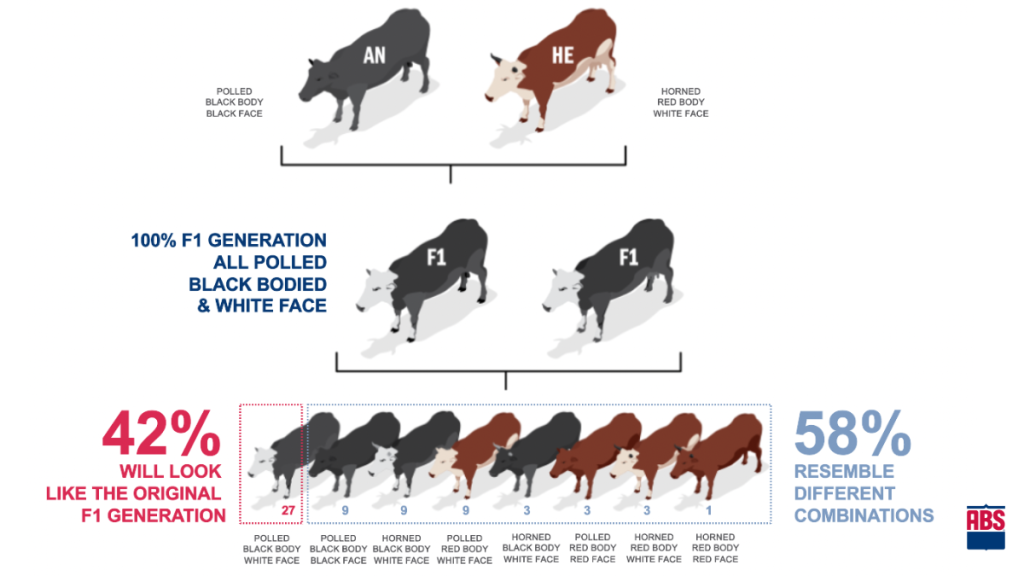Publish date: 9.28.23
A focused crossbreeding plan on a dairy is all about increasing efficiency and profits by lowering expenses such a feed, veterinary, and labor costs. The right dairy crossbreeding plan can deliver excellent production, superb health, and unrivaled fertility. Thus, dairy crossbreeding will help you create the problem-free herd you want. However, we know that not all crossbreeding plans or programs are created equal. The best way to maximize the benefits of crossbreeding on your dairy is through a customized breeding plan that is centered around your priorities.

Today, there has been lots of chatter around the idea of using F1 sires within your dairy crossbreeding program. Some are promoting breeding crossbred F1 sires to crossbred dams as a way to simplify breeding programs. However, at ABS, we are not sold on this as a solution that yields the best benefits for our customers. We believe using this type of breeding mentality could cause more damage than good in your herd.
Here are three reasons why we do not recommend breeding F1 sires to F1 dams.
1. Considerable Range of Phenotypic Variation for Resulting Progeny
Some believe using F1 sires on F1 dams will result in another uniform F1 animal. However, this is not the case. As you know, F1 animals are extremely uniform because they receive exactly fifty percent of their genetics from their sire and dam, respectively. Unlike when breeding purebred parents together, crossing F1 sires to F1 dams results in a considerable range of phenotypic variation amongst progeny. This is inconsistency occurs based on how genes are passed from one generation to the next. When a parent is an F1, it is possible for them to pass on Holstein or Jersey genes because their genetic make-up is 50% Holstein and 50% Jersey. Finally, genes are transmitted independently of each other, which means an F1 sire could transmit only Holstein genes, only Jersey genes, or a combination of both.
2. Lack of Selection Intensity in Crossbred Sires
There is a lack of selection intensity when it comes to crossbred genetics as compared to purebred sires. There are only a small number of F1 sires created, and today, nearly all of them enter stud. If we compare the averages for top 40 marketed F1 and purebred Jersey sires for Net Merit Dollar (NM$) based on the CDBC’s December 2022 Sire Summary data, you would find the average for F1 bulls was 611 and for purebred Jersey sires was 750. The 139 NM$ disadvantage is due to the lack of selection. Among F1 sires, the variation in genetic quality is caused by the lack of selection intensity.
3. Unreliability of Crossbred Genotypes
Currently, we do not have a great way to genotype crossbred animals because of the lack of a uniform data set. Crossbred animals are not able to use the same genotyping method as purebreds because they do not have a large library of genotypes and phenotypes. As it stands today, when crossbred animals receive a genotype, they are compared against each breed that is represented in their DNA. The results are compiled as a weighted average based on the percentage of each breed present which is not an accurate way to genotype cattle with many genetic combinations being breed-specific.
It is for these reasons that we do not recommend breeding F1 sires to F1 dams. However, we do recommend rotational crossing to maintain consistency, capitalize on heterosis, and make genetic progress. Although there are many ways to customize a crossbreeding program for a herd, there are three major crossbreeding programs we think you should consider: two-way crossing, three-way crossing, and terminal F1 crossing.
For example, using a terminal F1 Cross where F1 dams are bred to Beef InFocus sires to create a superior beef cross calf is one option to use. This is a great way to respond to market demands, maximize heterosis in an F1 herd, and use tools that are not available to fully crossbred herds, such as genomics.
Want to learn more about dairy crossbreeding? Contact your ABS Genetic Advisor or complete the form below.






